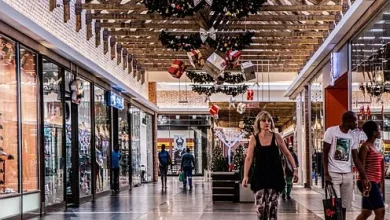Online vs offline – are physical stores starting to fight back?

More than half of UK consumers are now shopping online, with UK online spend forecasted to increase by 29.6% between 2019 and 2024, according to retail analysts at GlobalData. As a nation, we spend roughly £1 in every £5 online; a figure which has remained relatively steady in recent years.
As a consequence, we are seeing footfall decline in pretty much every major city and more and more retailers facing restructures, store closures and even administration.
Buying habits have changed and consumers increasingly want the ease, flexibility and convenience of browsing and buying online.
Not only can people no longer be bothered to trek into town for their latest buys, it’s just so much easier to pop online and order what you like with the freedom of having next day, or same day delivery. There’s little that can’t be ordered online – from furniture and electricals right down to food shopping and even your medication if that’s what works for you. They can probably all be bought from a single website.
It’s no coincidence that those brands which have recognised this shift to online and who have invested in their ecommerce platforms are benefitting significantly from a more loyal and profitable customer base.
Online retailing has more than proven itself. As has omni-channel as a winning channel mix; the ability to blend both the on and offline buying experience has proven a popular approach with today’s consumers. But what about those brands that chose to remain solely offline?
Or, in a more recent trend, chose to simply withdraw from online having previously built up some degree of web presence. What are the chances of them surviving the current retail apocalypse?
We’re in a period of rapid change and evolution in buying habits with more focus than ever on the experience a customer has. This is important, because there is no assumption that the experience has to follow current trends and be online. This gives physical stores a real opportunity to embrace a more sensory experience – something that simply cannot be replicated in the online space.
This means that in time, yes, we’re more likely to see a reduction of physical stores but for the ones that remain, they will make a more powerful impact.
Advances in retail technology means shopping will be a whole new, and exciting experience. There’ll be cashless environments, the use of artificial and virtual technology, connected devices and the consensual sharing of data which will bring a whole new level of appeal to making a trip out to the high street.
For these retailers, they also have the advantage of being able to let their customers touch, feel and interact with products ‘in the moment’, giving a degree of instant gratification that again cannot be achieved online.
More modern architectural and design influences in store refurbishment along a much greater understanding of how lighting, sound, aesthetics, connectivity and overall look and feel of a store means that bricks and mortar stores have a better chance than ever to fight back against online retailers.
Brand loyalty, and therefore engagement, has long been associated with more online experiences – the ability to capture electronic data about buying choices, habits and routines and then personalising buying journeys as a result therefore making it easier for a customer to complete their purchases.
However, physical retailing offers brands an opportunity to go back to basics and build real, tangible relationships with their customers. There are an increasing number of factors influencing consumer choice, from supporting local producers to purchasing ethically and understanding a products provenance.
This means retailers have a fine line to tread between their desire to maintain quality, rich and up to date data about their customers with a desire to be treated in a more human way.
Interestingly, there is a well-documented shift underway from the reliance that we have as a society on being connected all of the time, particularly with social media given the known impact this can have on mental health. For retailers, they must look for engagement strategies that help them build a connection with their customers without imposing on their personal space.
The human-to-human element of physical shopping experiences means brands are already on the front foot as a customer has consciously chosen to embrace that particular opportunity. For example, people that have used the styling service at John Lewis spend on average 30% more over the year following a session than those who don’t.
It’s a tricky time for offline retailers; customer want convenience, speed and simplicity in pretty much everything, at the same time as wanting deeper, more meaningful experiences and connections. Technology is going to be key and as a result, online in one form or another is going to be prevalent.
Surely, it’s those brands that embrace this, and all that a more omni-channel approach has to offer them, that are going to be the last ones standing in this unprecedented battle the retail sector is facing.
Contributed by end-to-end retail solution company Sigma







